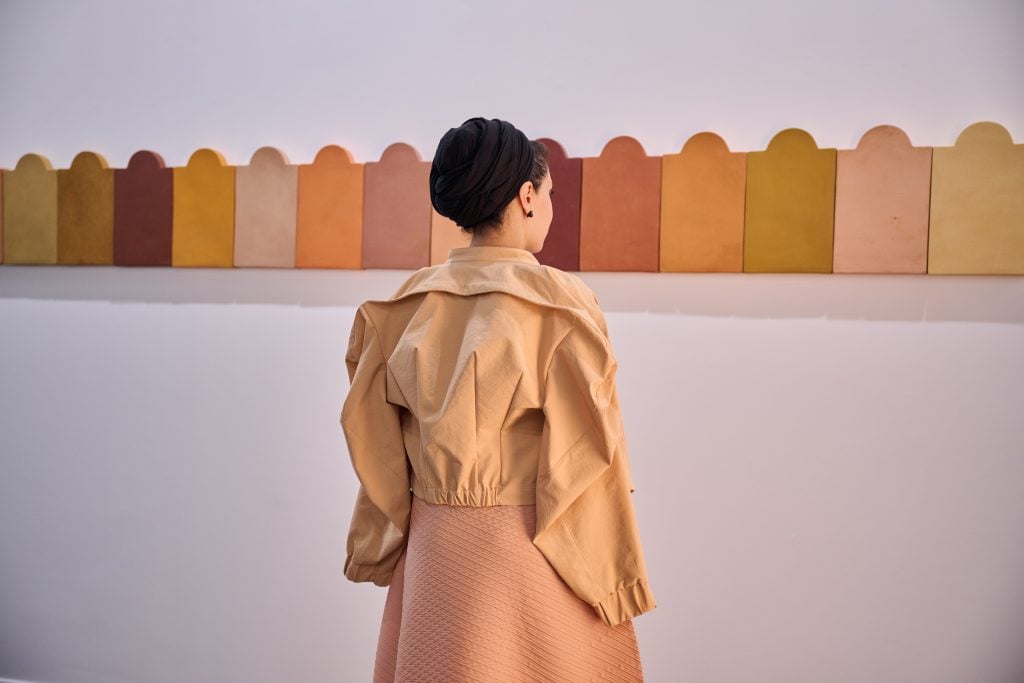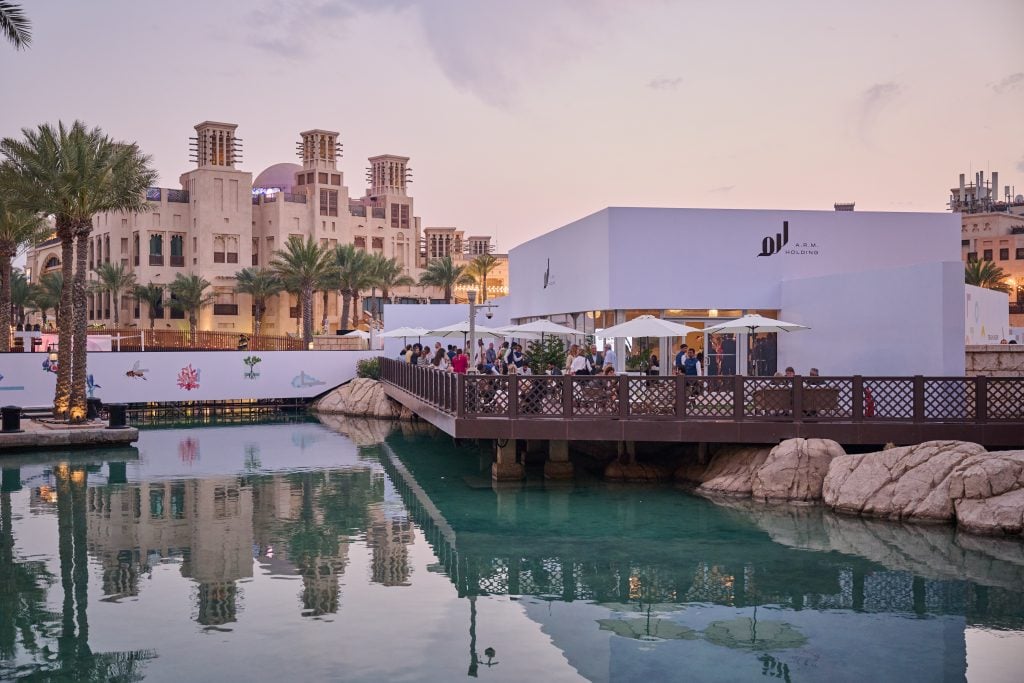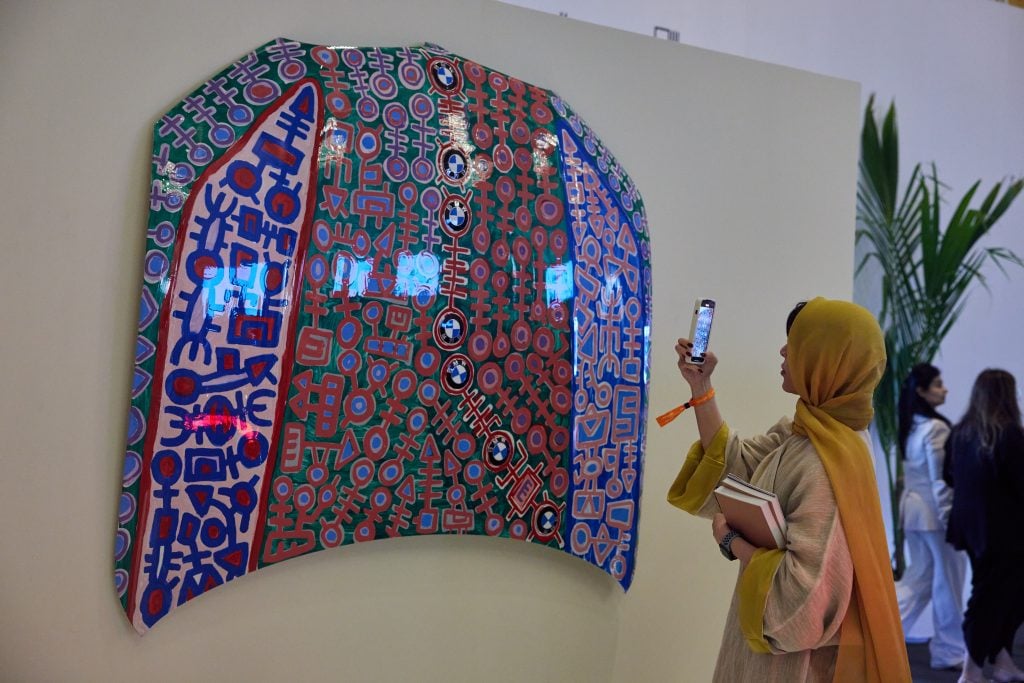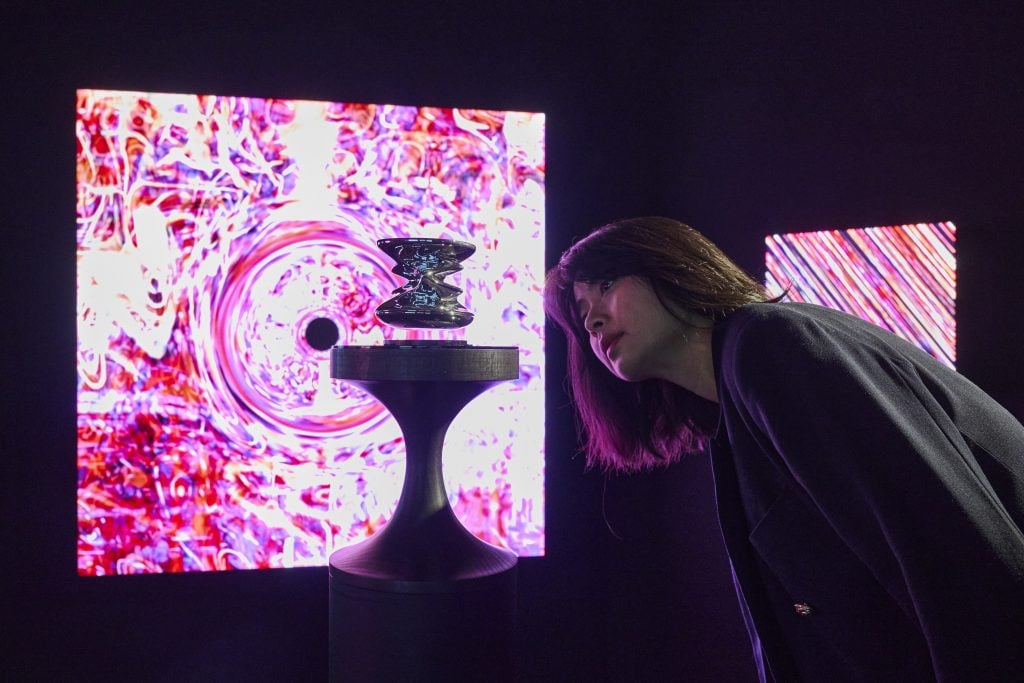Art Fairs
Dubai’s Art Market Sees the Benefit of a Post-Lockdown Property Boom—and the Influx of Russian Cash
VIPs flooded the opening days of Art Dubai for its biggest and most international edition yet.

VIPs flooded the opening days of Art Dubai for its biggest and most international edition yet.

Rebecca Anne Proctor

As fears of a global recession grip the world, a different atmosphere was witnessed on March 1 at the VIP opening of the 16th edition of Art Dubai in the United Arab Emirates’ sunny metropolis. It was the art fair’s biggest and most global edition yet, with 130 galleries from more 40 countries signaling the sprawling Gulf metropolis, known for its glistening ever expanding skyrises, as one of the world’s next major capitals for art and culture.
The scene, with dealers, collectors and art lovers out in the dozens, gathering under sunny skies at the Madinat Jumeirah, might have been unthinkable for Dubai pre-pandemic when the emirate had entered a grave recession caused by the drop in crude oil prices and a slump in the real estate market. Expats rushed back to their home countries in the thousands.
But this year the fair saw the benefit of Dubai’s post-pandemic economic gains thanks to a property boom and thousands of new residents and tourists. Among them are art collectors, who moved to the small Gulf nation during and post the pandemic eager to reap new business opportunities and enjoy the lifestyle that the UAE has long offered.
The UAE economy is projected to grow by 7.6 percent this year, the highest in 11 years, driven by both oil and non-oil sectors, according to the latest estimates by the UAE Central Bank. Another important driver of the growth is an influx of Russian cash from Russians fleeing consequences of the war with Ukraine, escaping Western sanctions in the paradisiacal beaches of the UAE. Property sales, which accounts for around 10 percent of Dubai’s GDP, were up 45 percent year on year in April and 51 percent in May 2022, according to the Dubai Land Department.

Holding Lounge, exterior view, Art Dubai 2023, until 5 March, Madinat Jumeirah, Dubai, United Arab Emirates. Photo by Spark Media for Art Dubai.
While hearing Russian spoken is now common throughout Dubai, in malls, by the pool and at the beach, very little was heard at Art Dubai.
“Everyone was expecting the Russians to be at the fair buying but where are they here?” quipped one Dubai-based collector on condition of anonymity. “They are not here or being super discreet. Some are saying that it is more likely if they want to buy art that they will send someone else to do the purchasing.”
“The Dubai boom is not thanks to the Russians who have relocated here, it is due to the way Dubai handled the pandemic and the influx of new residents to the city,” Pablo del Val, Art Dubai’s artistic director, told Artnet News, pointing to the success of the fair last year, mounted three weeks after the Russian invasion of Ukraine.
“When they came, they discovered a sophisticated place, well organized and with a great lifestyle,” he added. “Every dinner I go to now has people who have just moved to Dubai. The perception of the city has dramatically changed.”
The Russian influx has nevertheless affected the Dubai art market, as noted in the Art Basel and UBS Survey of Global Collecting that stated how “some additional inflows and outflows of trade, including in luxury objects and art works, have developed […] between Russia and the Gulf States or Turkey, as a result of the restrictive measures taken by the political ‘West.’”
“Everyone is relocating to Dubai from Europe,” said one London-based advisor on condition of anonymity. “Russian auction staff is moving to Dubai to work with staff here where there are no sanctions. This is all because of the war in Ukraine.”
Christie’s Dubai recently hired a Russian-speaking staff member who formerly worked at Moscow’s State Tretyakov Gallery prior to moving to Dubai a few years prior.

Installation view, Art Dubai 2023, until 5 March, Madinat Jumeirah, Dubai, United Arab Emirates. Photo by Spark Media for Art Dubai.
“Since Spring 2022, I have witnessed a large influx of the art professionals and creative entrepreneurs moving to Dubai from Russia,” Aleksei Afanasiev, gallery manager at Galleria Continua which opened a new permanent space inside the glitzy Burj Al Arab in November 2021, and is now showing the work of Daniel Buren (who was also at the fair).
Originally from Russia, Afanasiev has been living in Dubai since 2010. Today, he said that many Russians he meets in Dubai are looking for jobs or asking for advice in setting up their businesses. He has also met with a few established Russian collectors who are researching the market to understand more about regional Middle Eastern art.
“In a few weeks I found myself surrounded by a progressive group of likeminded people from Moscow and St. Petersburg, while for the past decade of my life in Dubai I barely made any Russian-speaking contacts, as the community looked completely different to what it is today. I am very excited to see this new circle willing to contribute to the cultural landscape of Dubai.”
Two Russian-owned galleries are soon opening in the industrial Al Quoz district of Dubai not far from Alserkal Avenue, the city’s art hub. There’s also a Russian owned digital art space that will open in Dubai Design District and several curators and art dealers are testing the ground in Dubai via direct sales or looking at organizing pop up exhibitions.
Russian-born Veronika Berezina, who resides between Dubai and Switzerland and is founder and director of NIKA Project Space, opening in Al Quoz on March 3, said she was attracted to the growing art scene and cosmopolitan character of Dubai. The art space will focus largely on conceptual art by a variety of regionally and internationally based artists with a particular focus on female artists.
“Dubai has changed a lot since the Covid,” Berezina said. “It’s more culturally-oriented with people from a variety of cultures and regions that creates a special mix—an interesting audience to have when working with Conceptual art.”

Installation view, Art Dubai 2023, until 5 March, Madinat Jumeirah, Dubai, United Arab Emirates. Photo by Cedric Ribeiro/Getty Images for Art Dubai.
Outside of the Russian chatter, the truly global character of the participating galleries was notable. Dubai, due to its geographic positioning at a nexus of regions has long been a cultural meeting point. Its airport is busier than London’s Heathrow and art dealers, among other businesses, have banked on Dubai’s transient and cosmopolitan nature as a premiere spot to do business. Since its founding 16 years ago, Art Dubai has done the same, but it is also doing so in character with the distinct cultures and nationalities that the city has long attracted.
Digital art and tech were again a focus this year, with the digital section stationed in Mina A’Salam hosting 22 participants up from 17 last year. While the rage for NFTs and crypto art wasn’t hyped as it was this time last year, the section presented a strong showing of them alongside other digital and new media art.
The enthusiasm all round resulted in brisk sales being made on the fair’s first two VIP days. Sales were made in the ten to triple digits to collectors, museums and private institutions in the Middle East, the United States, and Europe. A first time participant at the fair, the Ghanaian Efie Gallery, sold a vibrant textile work by Malian artist Abdoulaye Konaté for $52,000 to a Dubai-based collector on the first day. In keeping with the discretion prized in the emirate, another attribute which has drawn many to reside there, not all galleries disclose sales details—but there were whispers of several undisclosed sold works priced in the seven digits.
Further sales reported by the end of the weekend included a Tyler Hobbs NFT, which Unit London placed with a European private collector for $400,000; Lawrie-Shabibi sold two sculptures and 10 drawings by the late Jordanian artist Mona Saudi priced between $120,000 and $350,000 for the sculptures and at $18,000 for the drawings; and Beirut’s Sfeir-Semler sold several major paintings by MARWAN at undisclosed prices.